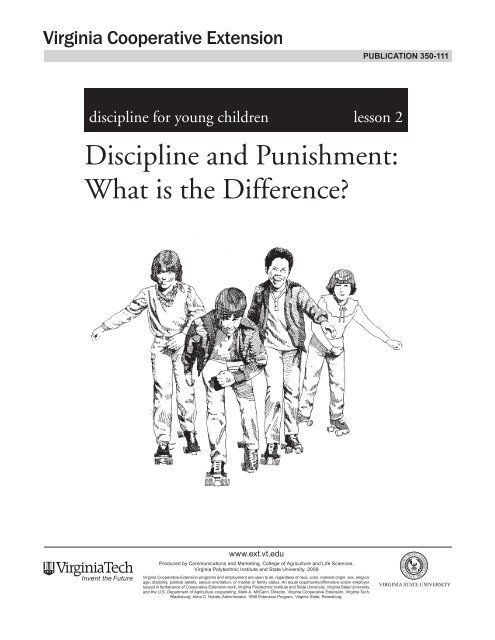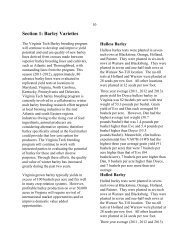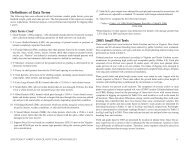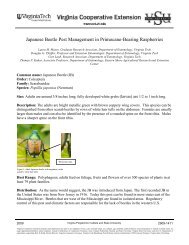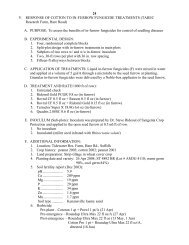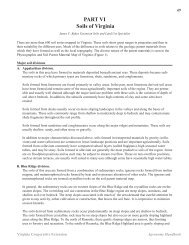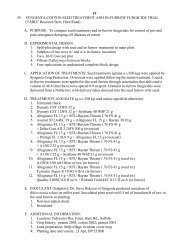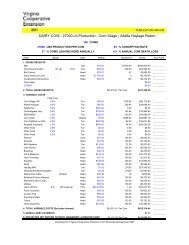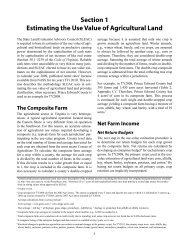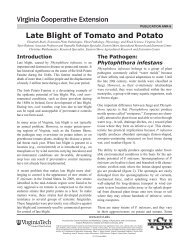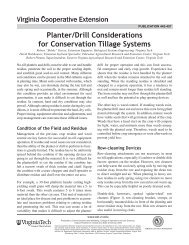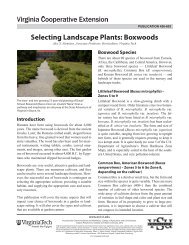Discipline and Punishment: What is the Difference? - Publications ...
Discipline and Punishment: What is the Difference? - Publications ...
Discipline and Punishment: What is the Difference? - Publications ...
Create successful ePaper yourself
Turn your PDF publications into a flip-book with our unique Google optimized e-Paper software.
d<strong>is</strong>cipline for young children lesson 2<br />
<strong>D<strong>is</strong>cipline</strong> <strong>and</strong> <strong>Pun<strong>is</strong>hment</strong>:<br />
<strong>What</strong> <strong>is</strong> <strong>the</strong> <strong>Difference</strong>?<br />
www.ext.vt.edu<br />
Produced by Communications <strong>and</strong> Marketing, College of Agriculture <strong>and</strong> Life Sciences,<br />
Virginia Polytechnic Institute <strong>and</strong> State University, 2009<br />
Virginia Cooperative Extension programs <strong>and</strong> employment are open to all, regardless of race, color, national origin, sex, religion,<br />
age, d<strong>is</strong>ability, political beliefs, sexual orientation, or marital or family status. An equal opportunity/affirmative action employer.<br />
Issued in fur<strong>the</strong>rance of Cooperative Extension work, Virginia Polytechnic Institute <strong>and</strong> State University, Virginia State University,<br />
<strong>and</strong> <strong>the</strong> U.S. Department of Agriculture cooperating. Mark A. McCann, Director, Virginia Cooperative Extension, Virginia Tech,<br />
Blacksburg; Alma C. Hobbs, Admin<strong>is</strong>trator, 1890 Extension Program, Virginia State, Petersburg.<br />
publication 350-111
<strong>D<strong>is</strong>cipline</strong> for Young Children<br />
Lesson 2: <strong>D<strong>is</strong>cipline</strong> <strong>and</strong> <strong>Pun<strong>is</strong>hment</strong>: <strong>What</strong> <strong>is</strong> <strong>the</strong> <strong>Difference</strong>?<br />
Effective d<strong>is</strong>cipline helps children learn to control <strong>the</strong>ir<br />
behavior so that <strong>the</strong>y act according to <strong>the</strong>ir ideas of what<br />
<strong>is</strong> right <strong>and</strong> wrong, not because <strong>the</strong>y fear pun<strong>is</strong>hment. For<br />
example, <strong>the</strong>y are honest because <strong>the</strong>y think it <strong>is</strong> wrong to be<br />
d<strong>is</strong>honest, not because <strong>the</strong>y are afraid of getting caught.<br />
The purpose of pun<strong>is</strong>hment <strong>is</strong> to stop a child from doing<br />
what you don’t want—<strong>and</strong> using a painful or unpleasant<br />
method to stop him.<br />
There are basically four kinds of pun<strong>is</strong>hment<br />
• physical pun<strong>is</strong>hment ‑ slapping, spanking, switching,<br />
paddling, <strong>and</strong> using a belt or hair brush.<br />
• verbal pun<strong>is</strong>hment ‑ shaming, ridiculing, using cruel<br />
words, saying “I don’t love you.”<br />
• withholding rewards ‑ “You can’t watch TV if you don’t<br />
do your homework.”<br />
• penalties ‑ “You broke <strong>the</strong> window so you will have to<br />
pay for it with money from your allowance.”<br />
The first two kinds of pun<strong>is</strong>hment, physical <strong>and</strong> verbal,<br />
are not considered to be effective d<strong>is</strong>cipline methods. The<br />
o<strong>the</strong>r two, withholding rewards <strong>and</strong> giving penalties, can<br />
be used ei<strong>the</strong>r as effective d<strong>is</strong>cipline methods or as pun<strong>is</strong>h‑<br />
ment—depending on how parents admin<strong>is</strong>ter <strong>the</strong>m.<br />
Mild or Harsh?<br />
It <strong>is</strong> important to look at <strong>the</strong> way parents admin<strong>is</strong>ter<br />
physical pun<strong>is</strong>hments.<br />
A swat on <strong>the</strong> bottom <strong>is</strong> a mild physical pun<strong>is</strong>hment.<br />
While it may do no permanent physical harm, it does not<br />
help <strong>the</strong> child develop a conscience. Instead, it teaches him<br />
that physical violence <strong>is</strong> an acceptable way of dealing with<br />
problems. Parents should avoid physical pun<strong>is</strong>hment. If <strong>the</strong>y<br />
find <strong>the</strong>mselves using it, <strong>the</strong>n something <strong>is</strong> wrong <strong>and</strong> <strong>the</strong>ir<br />
method of d<strong>is</strong>cipline <strong>is</strong> not working. They may as well admit<br />
that spanking <strong>is</strong> more effective in relieving <strong>the</strong> parents’ frus‑<br />
tration than in teaching <strong>the</strong> child self‑control. More effective<br />
methods are needed.<br />
Note: Since it <strong>is</strong> awkward to refer to <strong>the</strong> child as “he/she,” all references in <strong>the</strong>se lessons to <strong>the</strong> child as “he” refer to both boys <strong>and</strong> girls.<br />
By: Valya Telep, Former Extension Special<strong>is</strong>t, Child Development, 2 Virginia State University<br />
Harsh physical pun<strong>is</strong>hment <strong>and</strong> verbal abuse can never be<br />
justified as ways to d<strong>is</strong>cipline children. Parents usually spank<br />
when <strong>the</strong>y are angry; a parent may not realize how hard he <strong>is</strong><br />
striking <strong>the</strong> child. Verbal abuse hurts <strong>the</strong> child’s self concept.<br />
Why <strong>Pun<strong>is</strong>hment</strong> Doesn’t Work<br />
Physical pun<strong>is</strong>hment usually doesn’t work for several<br />
reasons. First, it makes <strong>the</strong> child hate himself <strong>and</strong> o<strong>the</strong>rs.<br />
Physical pun<strong>is</strong>hment makes <strong>the</strong> child think that <strong>the</strong>re must<br />
be something awfully wrong with him to be treated so badly.<br />
If children think <strong>the</strong>y are “bad,” <strong>the</strong>n <strong>the</strong>y will act “bad.”<br />
A vicious cycle <strong>is</strong> formed. The child who has been treated<br />
harshly has no reason to be good. Or he may be good just to<br />
keep from being pun<strong>is</strong>hed <strong>and</strong> not learn to be good because<br />
he thinks it <strong>is</strong> <strong>the</strong> right thing to do.<br />
Children who have been spanked feel that <strong>the</strong>y have paid<br />
for <strong>the</strong>ir m<strong>is</strong>behavior <strong>and</strong> are free to m<strong>is</strong>behave again. In<br />
o<strong>the</strong>r words, spanking frees <strong>the</strong> child from feelings of remorse<br />
which are needed to prevent future m<strong>is</strong>behavior.
Parents who use physical pun<strong>is</strong>hment are setting<br />
an example of using violence to settle problems or<br />
solve conflicts, Children imitate <strong>the</strong>ir parents’<br />
behavior. When parents use physical pun<strong>is</strong>h‑<br />
ment, children are more likely to use violent<br />
acts to settle <strong>the</strong>ir conflicts with o<strong>the</strong>rs.<br />
Ano<strong>the</strong>r d<strong>is</strong>advantage of using physical<br />
pun<strong>is</strong>hment <strong>is</strong> that parents have to find o<strong>the</strong>r<br />
d<strong>is</strong>cipline methods when <strong>the</strong> child becomes<br />
as tall <strong>and</strong> as strong as <strong>the</strong> parent! Why not<br />
start using effective d<strong>is</strong>cipline methods<br />
when <strong>the</strong> child <strong>is</strong> young?<br />
Where reward <strong>and</strong> pun<strong>is</strong>hment<br />
focus on <strong>the</strong> child, encouragement <strong>and</strong> reality d<strong>is</strong>cipline<br />
target <strong>the</strong> act. Reward <strong>and</strong> pun<strong>is</strong>hment teaches <strong>the</strong> child to be<br />
“good” as long as we are looking.<br />
When rewards are our chief way of motivating children<br />
we run <strong>the</strong> r<strong>is</strong>k of creating “carrot seekers”: children who are<br />
always looking for <strong>and</strong> expecting a reward every time <strong>the</strong>y do<br />
something good or right. If we give a child money for making<br />
h<strong>is</strong> bed th<strong>is</strong> week, he’ll wonder where h<strong>is</strong> money <strong>is</strong> next week.<br />
Instead of being self‑motivated by a desire to cooperate or<br />
help o<strong>the</strong>r family members, we have taught <strong>the</strong> child to look<br />
to us for h<strong>is</strong> source of motivation.<br />
Effective <strong>D<strong>is</strong>cipline</strong> . . .<br />
• Helps <strong>the</strong> child learn self‑control<br />
• Can be used with teenagers<br />
• Builds <strong>the</strong> child’s self‑esteem<br />
• Sets a good example of effective ways to solve problems.<br />
Harsh <strong>Pun<strong>is</strong>hment</strong> . . .<br />
• Teaches <strong>the</strong> child to deceive parents<br />
• Won’t work with teenagers<br />
• Tears down self‑esteem<br />
• Teaches <strong>the</strong> child that violence <strong>is</strong> an acceptable way to<br />
solve problems.<br />
Why do Parents Spank?<br />
Parents who spank <strong>the</strong>ir children ra<strong>the</strong>r than using o<strong>the</strong>r<br />
d<strong>is</strong>cipline methods usually say:<br />
“Nothing else works.”<br />
3<br />
“You’ve got to let kids know who <strong>is</strong> boss.”<br />
“They asked for it.”<br />
“It clears <strong>the</strong> air.”<br />
“I was spanked <strong>and</strong> I turned out OK.”<br />
Reasons for spanking which parents seldom<br />
give are:<br />
• They are mad at <strong>the</strong>ir husb<strong>and</strong> or wife<br />
<strong>and</strong> take it out on <strong>the</strong> child.<br />
• They are angry <strong>and</strong> don’t stop to<br />
think of better ways to d<strong>is</strong>cipline.<br />
• They don’t know how to d<strong>is</strong>cipline more effectively.<br />
• It relieves <strong>the</strong>ir feelings of frustration.<br />
• It <strong>is</strong> easier, quicker, <strong>and</strong> requires less thinking than o<strong>the</strong>r<br />
d<strong>is</strong>cipline methods.<br />
Some parents spank because <strong>the</strong>y place a high value on<br />
obedience. Their whole aim <strong>is</strong> for <strong>the</strong> child to “mind,” to<br />
do what he <strong>is</strong> told without question. There are times when a<br />
child needs to obey instantly, such as when he starts to run<br />
out in <strong>the</strong> street without looking.<br />
When obedience <strong>is</strong> <strong>the</strong> parent’s main objective, however,<br />
<strong>the</strong> child becomes passive <strong>and</strong> loses h<strong>is</strong> zest for life.<br />
The question of spanking <strong>is</strong> an emotional <strong>is</strong>sue which<br />
parents feel very strongly about. They can be divided into one<br />
of three groups. They think ei<strong>the</strong>r:<br />
(1) “Spare <strong>the</strong> rod <strong>and</strong> spoil <strong>the</strong> child.”<br />
(2) “I can’t imagine anyone<br />
laying a h<strong>and</strong> on a poor<br />
defenseless child.”<br />
(3 ) “O<strong>the</strong>r kinds of d<strong>is</strong>ci‑<br />
pline are more effective.“<br />
Parents who spank ask,<br />
“<strong>What</strong>’s wrong with it?” It <strong>is</strong>n’t a<br />
question of right or wrong, but<br />
of what <strong>is</strong> best for <strong>the</strong> child.<br />
Perhaps parents who
spank frequently should ask <strong>the</strong>mselves:<br />
Why do I use spanking as <strong>the</strong> only way to d<strong>is</strong>cipline my<br />
child?<br />
Does spanking work?<br />
How did I feel when I was spanked as a child?<br />
Did it make me stop doing what I was spanked for,<br />
or—<br />
Did I sneak around <strong>and</strong> try not to get caught doing it?<br />
Often, attitudes toward physical pun<strong>is</strong>hment reflect<br />
religious beliefs <strong>and</strong> ideas about what children are like. Child<br />
development educators believe that <strong>the</strong> child <strong>is</strong> born nei<strong>the</strong>r<br />
good nor bad; <strong>the</strong>y have <strong>the</strong> possibility of becoming good or<br />
bad according to how <strong>the</strong>y are treated, <strong>the</strong> kind of experienc‑<br />
es <strong>the</strong>y have, <strong>and</strong> <strong>the</strong>ir reaction to <strong>the</strong>ir environment. Since<br />
<strong>the</strong>se educators believe that children are not naturally bad,<br />
<strong>the</strong>y think children need to be d<strong>is</strong>ciplined in ways which help<br />
<strong>the</strong>m learn to do what <strong>is</strong> “right” ra<strong>the</strong>r than be pun<strong>is</strong>hed.<br />
Harsh d<strong>is</strong>cipline focuses anger on <strong>the</strong> parent.<br />
Effective <strong>D<strong>is</strong>cipline</strong> allows children to “hurt from<br />
<strong>the</strong> inside out” <strong>and</strong> focus on <strong>the</strong>ir actions.<br />
4<br />
Using Consequences as a Form of<br />
<strong>D<strong>is</strong>cipline</strong><br />
Letting children experience <strong>the</strong> consequences of <strong>the</strong>ir<br />
dec<strong>is</strong>ions <strong>is</strong> a “hassle‑free” way to d<strong>is</strong>cipline young people.<br />
Children learn from experiences, just like adults. We call it<br />
learning <strong>the</strong> “hard way.” The child learns that every act has<br />
a consequence for which he <strong>is</strong> responsible.<br />
Parents can declare that <strong>the</strong> consequence of not coming<br />
to <strong>the</strong> dinner table in time to eat <strong>is</strong> that <strong>the</strong> child does not<br />
eat h<strong>is</strong> dinner that evening. Hunger <strong>is</strong> a natural conse‑<br />
quence of not eating. If <strong>the</strong> child complains, mo<strong>the</strong>r can<br />
say, “I’m sorry you feel hungry now. It’s too bad, but you’ll<br />
have to wait for breakfast.” The child who experiences <strong>the</strong><br />
unpleasant consequences of h<strong>is</strong> behavior will be less likely<br />
to act that way again.<br />
Parents should tell <strong>the</strong> child, before it happens, what<br />
<strong>the</strong> consequences are for breaking a rule. If <strong>the</strong> child knows<br />
that <strong>the</strong> consequence of not getting to <strong>the</strong> dinner table<br />
in time to eat with <strong>the</strong> family <strong>is</strong> not eating, <strong>the</strong>n he has a<br />
choice. He can choose to get home in time to eat, or he<br />
can choose to be late <strong>and</strong> not eat. He must underst<strong>and</strong> that<br />
he has a choice <strong>and</strong> that he must accept <strong>the</strong> consequences<br />
of that choice.<br />
The child also needs to know <strong>the</strong> reason for <strong>the</strong> con‑<br />
sequence; for example, it <strong>is</strong> extra work to keep food warm<br />
<strong>and</strong> inconsiderate of o<strong>the</strong>r family members.<br />
It <strong>is</strong> important, too, that parents be willing to accept<br />
<strong>the</strong> child’s dec<strong>is</strong>ion; that <strong>is</strong>, <strong>the</strong>y must be willing to allow<br />
<strong>the</strong> child to go without dinner if he chooses to m<strong>is</strong>s <strong>the</strong><br />
meal. A general rule of thumb <strong>is</strong>: always give a couple of<br />
choices, provided <strong>the</strong>y are choices <strong>the</strong> parent can live with.<br />
Natural Consequences<br />
Natural consequences allow children to learn from <strong>the</strong><br />
natural order of <strong>the</strong> world. For example, if <strong>the</strong> child doesn’t<br />
eat, he will get hungry. If he doesn’t do h<strong>is</strong> homework, he<br />
will get a low grade. The parent allows unpleasant but natural<br />
consequences to happen when a child does not act in a desir‑<br />
able way.<br />
Logical Consequences<br />
Logical consequences are arranged by parents. The<br />
consequence must logically follow <strong>the</strong> child’s behavior. For<br />
example, not having clean clo<strong>the</strong>s to wear <strong>is</strong> a logical con‑<br />
sequence of not placing dirty clo<strong>the</strong>s in <strong>the</strong> hamper.
Consequences Teach Responsibility<br />
Kr<strong>is</strong>tin left her dirty clo<strong>the</strong>s on <strong>the</strong> floor <strong>and</strong> never<br />
placed <strong>the</strong>m in <strong>the</strong> dirty clo<strong>the</strong>s bag as mo<strong>the</strong>r requested.<br />
Nagging, scolding, <strong>and</strong> threatening did no good. Kr<strong>is</strong>tin<br />
continued to leave her dirty clo<strong>the</strong>s on <strong>the</strong> floor.<br />
Mo<strong>the</strong>r decided to use logical consequences. She told<br />
Kr<strong>is</strong>tin, in a firm <strong>and</strong> friendly voice, that in <strong>the</strong> future she<br />
would wash only clo<strong>the</strong>s that were placed in <strong>the</strong> bag. After<br />
five days, Kr<strong>is</strong>tin had no clean clo<strong>the</strong>s to wear to school<br />
<strong>and</strong> she was very unhappy to have to wear dirty, rumpled<br />
clo<strong>the</strong>s. After that, Kr<strong>is</strong>tin remembered to place her clo<strong>the</strong>s<br />
in <strong>the</strong> bag.<br />
Kr<strong>is</strong>tin’s mo<strong>the</strong>r gave her <strong>the</strong> responsibility for placing<br />
her clo<strong>the</strong>s in <strong>the</strong> proper place to be washed. If mo<strong>the</strong>r<br />
had relented <strong>and</strong> washed Kr<strong>is</strong>tin’s clo<strong>the</strong>s when she had<br />
not placed <strong>the</strong>m in <strong>the</strong> bag, she would have deprived her<br />
of an opportunity to learn to take responsibility for herself.<br />
If parents protect children from <strong>the</strong> consequences of <strong>the</strong>ir<br />
behavior, <strong>the</strong>y will not change <strong>the</strong>ir behavior.<br />
Some parents would not be willing for <strong>the</strong>ir child to go<br />
to school in dirty, rumpled clo<strong>the</strong>s. Only <strong>the</strong>y can decide if<br />
<strong>the</strong>y want to offer <strong>the</strong> child that particular consequence.<br />
Using consequences can help a child develop a sense<br />
of accountability. It leads to warmer relationships between<br />
parents <strong>and</strong> children <strong>and</strong> to fewer conflicts. The situation<br />
itself provides <strong>the</strong> lesson to <strong>the</strong> child.<br />
Natural Consequences Cannot Be Used in all<br />
Situations<br />
Parents cannot use natural consequences if <strong>the</strong><br />
health or safety of <strong>the</strong> child <strong>is</strong> involved. If a young<br />
child runs into <strong>the</strong> street without looking, it <strong>is</strong><br />
not possible to wait until he <strong>is</strong> hit by a car—a<br />
natural consequence—to teach him not to run<br />
into <strong>the</strong> street. Instead, he should be taken into<br />
<strong>the</strong> house <strong>and</strong> told, “Since you ran into <strong>the</strong><br />
street without looking, you cannot<br />
play outside now. You can come out<br />
when you decide to look before go‑<br />
ing into <strong>the</strong> street.”<br />
Th<strong>is</strong> <strong>is</strong> a logical conse‑<br />
quence. Because running into<br />
<strong>the</strong> street can harm <strong>the</strong> child,<br />
he cannot play outside until he<br />
learns to play safely in <strong>the</strong> yard.<br />
He has a choice; he can stay out<br />
of <strong>the</strong> street or he can go inside.<br />
5<br />
He <strong>is</strong> given responsibility for h<strong>is</strong><br />
behavior <strong>and</strong> any consequences<br />
he experiences (going<br />
inside) are <strong>the</strong> result<br />
of h<strong>is</strong> own behavior.<br />
You can begin giving<br />
choices as soon as <strong>the</strong><br />
child can experience<br />
<strong>the</strong> consequence of<br />
h<strong>is</strong> behavior. For<br />
example, a very<br />
young child who<br />
plays with h<strong>is</strong> food<br />
instead of eating can<br />
be lovingly removed<br />
from h<strong>is</strong> highchair<br />
<strong>and</strong> told, “All done!”<br />
It won’t take long before he sees<br />
he has a choice: he can be up in <strong>the</strong> highchair eating <strong>and</strong><br />
getting positive attention from <strong>the</strong> parent; or he can be<br />
hungry on <strong>the</strong> floor.<br />
Consequences Are Learning Experiences<br />
The purpose of using consequences <strong>is</strong> to help <strong>the</strong> child<br />
learn to make dec<strong>is</strong>ions <strong>and</strong> to be responsible for h<strong>is</strong> own<br />
behavior. Consequences are learning experiences, not pun<strong>is</strong>h‑<br />
ment. For example, if fa<strong>the</strong>r yells angrily at h<strong>is</strong> child, “Put<br />
up your toys or you can’t watch TV,” he <strong>is</strong> not encouraging<br />
<strong>the</strong> child to make a responsible dec<strong>is</strong>ion. However, if he says<br />
calmly <strong>and</strong> in a friendly voice, “Stuart, feel free to watch TV<br />
as soon as your toys are picked up,” he allows Stuart to make<br />
a choice. The secret of using consequences effectively <strong>is</strong> to<br />
stay calm <strong>and</strong> detached. Allow <strong>the</strong> consequences to be <strong>the</strong><br />
“bad guy”—not you!<br />
Parents cannot apply consequences if <strong>the</strong>y are<br />
angry. They cannot conceal <strong>the</strong>ir anger from <strong>the</strong><br />
child—<strong>the</strong>ir voices will give <strong>the</strong>m away. Try to<br />
view <strong>the</strong> situation objectively—as though <strong>the</strong><br />
child were a neighbor’s child <strong>and</strong> not your<br />
own—<strong>and</strong> admin<strong>is</strong>ter <strong>the</strong> consequences in<br />
a firm <strong>and</strong> kindly manner. Remember that<br />
giving a child a choice <strong>and</strong> allowing him to<br />
experience <strong>the</strong> consequences <strong>is</strong> one of <strong>the</strong><br />
best ways that children learn.<br />
Consequences work when <strong>the</strong> child <strong>is</strong> trying<br />
to get <strong>the</strong> parent’s attention by m<strong>is</strong>behaving <strong>and</strong><br />
when children fight, dawdle, <strong>and</strong> fail to do <strong>the</strong>ir<br />
chores. Consequences can be used to get children<br />
to school on time, to meals on time, <strong>and</strong> to take<br />
responsibility for homework. The child learns that
if he doesn’t pick up h<strong>is</strong> toys, he can’t go out <strong>and</strong> play; if he<br />
doesn’t wash h<strong>is</strong> h<strong>and</strong>s before meals, he won’t be served any<br />
food; <strong>and</strong> if he fights with h<strong>is</strong> bro<strong>the</strong>r while in <strong>the</strong> car, <strong>the</strong> car<br />
will be stopped until calm resumes.<br />
Using Consequences Takes Practice<br />
It <strong>is</strong> not easy to use consequences as a way to d<strong>is</strong>cipline<br />
children. It <strong>is</strong> hard work to think of consequences that really<br />
are logical. And it requires lots of patience! Sometimes it takes<br />
several weeks to get results.<br />
Parents are so used to telling children what to do that it <strong>is</strong><br />
very difficult to sit back <strong>and</strong> let <strong>the</strong> child experience <strong>the</strong> con‑<br />
sequences of h<strong>is</strong> actions. The effort <strong>is</strong> well worth it, however,<br />
because you are sending a powerful message to <strong>the</strong> child that<br />
says, “you are capable of thinking for yourself.”<br />
The differences between consequences <strong>and</strong> pun<strong>is</strong>hment are:<br />
Consequences <strong>Pun<strong>is</strong>hment</strong><br />
calm tone of voice angry tone of voice<br />
friendly but firm attitude hostile attitude<br />
willing to accept <strong>the</strong> child’s dec<strong>is</strong>ion unwilling to give a choice<br />
DISCIPLINE VS PUNISHMENT<br />
To <strong>D<strong>is</strong>cipline</strong> Effectively,<br />
Think About These Ideas:<br />
1. Effective d<strong>is</strong>cipline methods work better than pun<strong>is</strong>hment in teaching children how to behave.<br />
2. The more parents use effective d<strong>is</strong>cipline methods, <strong>the</strong> less children need pun<strong>is</strong>hment.<br />
3. There <strong>is</strong> no excuse for using physical or verbal pun<strong>is</strong>hment to d<strong>is</strong>cipline a child.<br />
4. Using consequences as a d<strong>is</strong>cipline method helps children learn to take responsibility for <strong>the</strong>ir behavior.<br />
5. Consequences must be logically related to <strong>the</strong> m<strong>is</strong>behavior.<br />
6. The child must see <strong>the</strong> relationship between h<strong>is</strong> m<strong>is</strong>behavior <strong>and</strong> <strong>the</strong> consequences or it will not work.<br />
7 The child must know he has a choice when consequences are used.<br />
8. Use consequences in a firm, kind, friendly manner.<br />
6
SEE HOW MUCH YOU HAVE LEARNED!<br />
Place a check by <strong>the</strong> phrase which best completes <strong>the</strong> sentence.<br />
1. Harsh pun<strong>is</strong>hment teaches a child<br />
_________ a. self‑control.<br />
_________ b. to use violence to solve problems.<br />
_________ c. to respect h<strong>is</strong> parents.<br />
2. Effective d<strong>is</strong>cipline methods help children learn<br />
_________ a. to behave according to <strong>the</strong>ir ideas of right <strong>and</strong> wrong.<br />
_________ b. to be sneaky <strong>and</strong> not get caught m<strong>is</strong>behaving.<br />
_________ c. to fear <strong>the</strong>ir parents<br />
3. Child development educators think that children are born<br />
_________ a. bad.<br />
_________ b. good.<br />
_________ c. with <strong>the</strong> possibility of becoming ei<strong>the</strong>r good or bad.<br />
4. A natural consequence of leaving dirty clo<strong>the</strong>s on <strong>the</strong> floor <strong>is</strong><br />
_________ a. having to wear dirty clo<strong>the</strong>s.<br />
_________ b. not being able to watch TV.<br />
_________ c. having a parent pick up after you.<br />
Practice Exerc<strong>is</strong>es<br />
1. Take a good look at <strong>the</strong> way you d<strong>is</strong>cipline your children th<strong>is</strong> week. Make a note below of each occurrence.<br />
<strong>What</strong> <strong>the</strong> child did: <strong>What</strong> I did:<br />
2. Then, ask yourself: “Did <strong>the</strong> d<strong>is</strong>cipline work?” “Would I do <strong>the</strong> same again?” “Can I think of a better way to h<strong>and</strong>le it next time?”<br />
3. Try using logical consequences th<strong>is</strong> week. Pick some behavior that doesn’t get you “uptight.” It <strong>is</strong> difficult to learn a new<br />
d<strong>is</strong>cipline method when you are upset.<br />
(a) <strong>What</strong> did <strong>the</strong> child do?<br />
(b) <strong>What</strong> consequences did you <strong>and</strong> <strong>the</strong> child decide on?<br />
(c) <strong>What</strong> happened? Did it work?<br />
7<br />
4. A<br />
3. C<br />
2. A<br />
1. B<br />
ANSWERS
A RECORD OF MY DISCIPLINE PRACTICES AND THEIR EFFECTS*<br />
Complete one week after studying Lesson 2.<br />
Check <strong>the</strong> blanks that apply to you.<br />
1. The way I usually d<strong>is</strong>cipline:<br />
_______ Yell <strong>and</strong> scream ______ Isolate<br />
_______ Explain reasons calmly ______ Spank<br />
_______ Remove privileges ______ Let <strong>the</strong> child experience <strong>the</strong> consequences<br />
_______ Give choices ______ Threaten, but don’t follow through<br />
_______ Show d<strong>is</strong>approval ______ D<strong>is</strong>tract<br />
_______ Ignore m<strong>is</strong>behavior<br />
_______ Scold<br />
2. During <strong>the</strong> past week, I:<br />
Acted calmly<br />
Acted firmly <strong>and</strong> kindly<br />
Used kind words, not unkind words<br />
Gave choices <strong>and</strong> let <strong>the</strong> child learn from <strong>the</strong> consequences<br />
3. The atmosphere in our home has changed to one of:<br />
Friendliness<br />
Cooperation<br />
Underst<strong>and</strong>ing<br />
Confusion<br />
Fun<br />
Hostility<br />
Tension<br />
*Adapted from Practical Education for Parenting by Kent G. Hamdorf, Extension Special<strong>is</strong>t, Human Relations Family Development, Ohio Cooperative Extension Service, 1978.<br />
8<br />
More Less About <strong>the</strong> same<br />
More Less About <strong>the</strong> same<br />
Reviewed by Novella Ruffin, Extension special<strong>is</strong>t, Virginia State University


